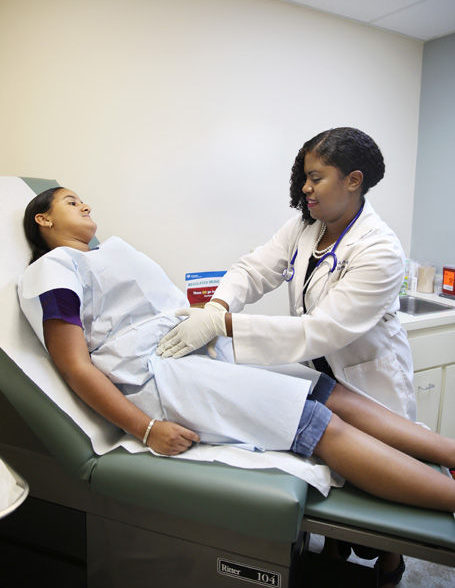
The human body plays host to a number of microorganisms that people don’t often have reason to think about, or even know about. Such is E-coli bacteria, which, depending on the particular strain, can spend their life cycles harmlessly hanging out in the intestines as the “good bacteria.” Other strains, however, are pathogens, and can cause pain, sickness, even death.
Dr. Aisha Thomas-St. Cyr specializes in infectious diseases. She moved to Sebastian from Baltimore about a year ago, and has her practice, Sebastian ID Care, in the Bay Street Medical Center. Dr. Thomas-St. Cyr talks about the E. coli bacteria, what it can do and how people can guard against its dangers.
Escherichia (E. for short) coli are a large and diverse group of bacteria. The dangerous strains can cause urinary tract infection, respiratory illness, pneumonia and other foodborne illnesses. They are found in the environment, in certain fresh foods and in the intestines of people and animals. These dangerous E. coli strains enter the body, said Thomas-St. Cyr, when fecal matter containing the bacteria is ingested.
Some kinds of E. coli, called STEC, cause disease by making a toxin called Shiga toxin. A strain of this, EHEC, caused a large outbreak in Europe in 2011. The most common identified STEC strain in North America is a Shiga-toxin-producing E. coli bacteria often referred to in news reports as E. coli 0157 or simply 0157.
Symptoms of STEC infections often include severe stomach cramps, diarrhea (often bloody), vomiting, and occasionally a low grade fever. Symptoms usually appear within 3-4 days of ingesting the bacteria. A person experiencing severe cramps and bloody stools should seek medical attention immediately, says Thomas-St. Cyr.
Individuals most susceptible to these aggressive and harmful strains are typically the elderly, the very young and those with compromised immune systems, but anyone can become sick. In Third World countries, says Thomas-St. Cyr, intestinal bacterial infections are the leading cause of death in young children. While these diseases can be successfully treated in developed counties, treatment available for children of Third World countries is impeded because they often have no access to antibiotics or clean, safe water, thus the extreme dehydration caused by the vomiting and diarrhea results in renal failure and death.
How are these infections spread? They start when a person ingests a usually invisible amount of human or animal feces. Unfortunately, this happens more often than we want to think about. Exposures include consumption of contaminated food, raw milk, water that has not been disinfected, contact with cattle or human feces (working with cattle or changing diapers, are obvious possible risks.)
Sometimes risks are less obvious – eating undercooked hamburger or contaminated lettuce, swallowing water while swimming, touching the environment in a petting zoo, or eating food prepared by people who haven’t washed their hands. Unfortunately, almost everyone has some risk of infection.
So far this year, according to the CDC (Center for Disease Control) 19 people from six states have been infected, most in the Northwest, with Washington State reporting 11 cases. Barbara Progulske, Environmental Consultant for the Florida Department of Health in Indian River County, says very few reportable cases of STEC are seen in Indian River County: 1 so far this year; 0 in 2013; 1 in 2012; and 3 in 2011.
Regardless of the potential risks of contracting a dangerous E-coli infection, Thomas-St. Cyr says people should not stop eating fresh fruits and vegetables, which are important to good health maintenance in many ways.
The exception to this, she hastens to add, is when travelling abroad. Then it is wisest to drink only treated water and eat NO raw fruits or vegetables. The severity of Montezuma’s Revenge can only be appreciated by those who have, unfortunately, experienced it firsthand.
Otherwise, keep eating those healthy foods, and simply get in the habit of always taking certain, logical precautions: Rinse all raw fruits and vegetables, Thomas-St. Cyr stresses, even the ones with thick skins. A colander works well, and a triple-rinse is advised. Even, she adds, rinse that convenient salad in a bag that says it’s ready-to-eat. It won’t be ready-to-eat until it’s been triple-rinsed. Hand washing is ALWAYS important, as well. She refers to the CDC’s quick check-list of how to protect yourself from STEC infections:
• WASH YOUR HANDS thoroughly after using the bathroom or changing diapers and before preparing or eating food. WASH YOUR HANDS after contact with animals or their environments (at farms, petting zoos, fairs, even your own backyard).
• COOK meats thoroughly. Ground beef and meat that has been needle-tenderized should be cooked to a temperature of at least 160°F/70˚C. It’s best to use a thermometer, as color is not a very reliable indicator of “doneness.”
• AVOID raw milk, unpasteurized dairy products, and unpasteurized juices (like fresh apple cider).
• AVOID swallowing water when swimming or playing in lakes, ponds, streams, swimming pools and backyard “kiddie” pools.
• PREVENT cross contamination in food preparation areas by thoroughly washing hands, counters, cutting boards, and utensils after they touch raw meat. To learn more about how to protect yourself from E. coli, see CDC’s feature, E. coli Infection.
These suggestions are very basic stuff, things we’ve all heard before. But keep in mind, the simple act of washing your hands – or your lettuce – or not, can mean the difference between getting sick or staying healthy, so you can keep on not thinking about those microscopic trouble-makers.



